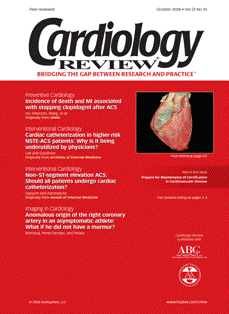MOC Questions
Preparing for the American Board of Internal Medicine Maintenance of Certification
The following questions can assist candidates prepare for the Maintenance of Certification Exam in Cardiovascular Disease. Feedback regarding these questions is welcomed and can be sent to editor@cardiology-review.com.
These questions were prepared by Michael W. Rich, MD.
Questions
1. Which of the following is the most effective treatment intervention for multifocal atrial
tachycardia (MAT)?
a) Treating the underlying cause of the arrhythmia
b) Adenosine
c) Amiodarone
d) Diltiazem
e) Digoxin
2. Which of the following is the most effective treatment intervention for decreasing sudden cardiac death and increasing survival in a patient with systolic dysfunction heart failure with ventricular arrhythmias?
a) An angiotensin-converting enzyme (ACE) inhibitor at full dose
b) An angiotensin receptor blocker (ARB) at full dose
c) Combined ACE inhibitor and ARB, each at moderate dose
d) Amiodarone
e) Use of an implantable cardioverter-defibrillator (ICD)
3. A 70-year-old adult has a blood pressure of 170/60 mm Hg. Before initiating treatment for isolated systolic hypertension (ISH), careful cardiac auscultation should be done to rule out which of the following?
a) Aortic stenosis
b) Aortic regurgitation
c) Mitral stenosis
d) Mitral regurgitation
e) Mitral valve prolapse
4. Which of the following patients is most likely to have heart failure secondary to pure diastolic dysfunction with normal ejection fraction?
a) A 35-year-old man with a history of alcoholic cardiomyopathy
b) A 50-year-old man with a previous myocardial infarction (MI)
c) A 50-year-old woman with a previous MI
d) A 65-year-old man with congestive cardiomyopathy
e) A 65-year-old woman with longstanding hypertension
Answers
1: a
Multifocal atrial tachycardia (MAT) is a rapid, irregularly irregular rhythm with multiple ectopic atrial pacemakers. It is distinguished from atrial fibrillation by recognition of multiple P waves of differing morphologies. The key clinical point to remember about
MAT is that this rhythm most typically occurs as a result of severe pulmonary disease and/or in association with significant comorbidities such as septicemia, shock/hypovolemia, acidosis, electrolyte disturbance, and/or hypoxemia. Identifying and correcting the underlying cause of MAT offers the best chance for successful treatment.
2: e
Medical treatment with an angiotensin-converting enzyme inhibitor, angiotensin receptor blocker, beta blocker, aldosterone, and/or combined hydralazinenitrate preparation (ie, BiDil) has been shown to increase survival of patients with systolic dysfunction
heart failure; however, the most effective measure for prolonging survival of patients with end-stage heart failure is use of an implantable cardioverter defibrillator (ICD). Patients with heart failure are living longer because of treatment with the aforementioned
medications. As a result, the most common terminal event for patients with end-stage systolic dysfunction heart failure is sustained ventricular tachycardia or ventricular fibrillation. Implantation of an ICD has an amazingly high success rate for achieving
cardioversion/defibrillation of these malignant ventricular arrhythmias. Amiodarone alone (without an ICD) has not been shown to prolong life in these individuals.
3: b
A blood pressure of 170/60 mm Hg represents isolated systolic hypertension (ISH); however, before initiating antihypertensive treatment for this form of essential hypertension, one should carefully auscultate the heart to rule out the possibility of aortic regurgitation. This valvular lesion is characterized by an elevated systolic blood pressure and a wide pulse pressure. Aortic regurgitation produces a soft, often short, diastolic blowing murmur that can be difficult to detect unless specifically listened for. The murmur is heard best with the stethoscope placed along the lower left sternal border with the patient in the sitting position, leaning forward, in forced expiration. In contrast to the wide pulse pressure seen with aortic regurgitation, the murmur of aortic stenosis typically produces a low systolic blood pressure reading with a narrow pulse pressure (ie, a blood pressure in the range of 100/80 mm Hg). Blood pressure readings of mitral stenosis, mitral regurgitation, and mitral valve prolapse do not produce characteristic blood pressure findings.
4: e
A diagnosis of diastolic dysfunction is based on the echocardiographic findings of a normal or increased ejection fraction that occurs in association with concentric
hypertrophy, reduced ventricular compliance, and the absence of significant valvular disease, such as mitral or aortic regurgitation, each of which may result in an enhanced ejection fraction. Patients with diastolic dysfunction also often manifest left atrial enlargement—because a thickened, stiffened left ventricle is more difficult to fill, it is more likely to predispose to increased left atrial pressures and left atrial enlargement. By far, the most common cause of heart failure from pure diastolic dysfunction is longstanding hypertension. This entity is especially common in older women who do
not have a history of coronary artery disease. In contrast, the type of heart failure typically seen in patients with chronic alcohol abuse or congestive cardiomyopathy
is associated with a dilated, poorly contractile ventricle. The finding of focal areas of akinetic or hypokinetic myocardium suggests an ischemic component to the cardiomyopathy from previous MI.
